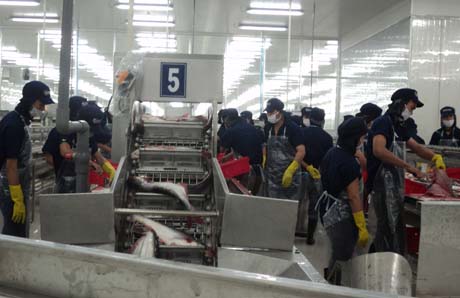Seafood sector: Rays of sunlight in marketplace
The Vietnamese seafood sector has expanded its footprint in the global marketplace, particularly live and frozen shrimp, much to the chagrin of China and Thailand, thanks to their high quality and disease free seafood products.
 |
| Illustration photo (Photo: Thai Thien) |
While the traditional leading Asian market sales plummet as a direct result of the EMS breakout earlier this year, the Vietnam seafood sector is cashing in, having experienced strong growth in three key markets – the RoK, EU and US – in the 10 months leading up to November.
The Ministry of Agricultural and Rural Development (MARD) in turn is now forecasting that shrimp exports will reach US$3.6 billion in 2014, up from US$3.1 billion in 2013, an event barely fathomable at this time last year.
As a perfect example, RoK imports of the country’s shrimp have skyrocketed to over 150.2% of last year’s volume to 19,646 tonnes at the expense of their counterparts in China and Thailand, resulting in an 11% jump in market share to 44%.
The overall export value of shrimp to the RoK also vaulted to an estimated 187.2% higher than last year to US$ 205.3 million, which is principally attributable to the increased volume. Though in recent weeks the price of shrimp has stabilized and all indications are that it is on the uptick.
At present, the RoK remains the fifth largest shrimp importer of Vietnam trailing the US, Japan, EU and China from largest to smallest in terms of volume. The uptrend in shrimp exports has also had a spill over effect, positively benefiting cuttlefish and octopus exports.
Apart from shrimp, exports of octopus and cuttlefish to the RoK in the ten month period have also spiralled upwards to 131.5% of last year’s corresponding figure and now comprise 35% of market share.
Cuttlefish and octopus see promising opportunities
The RoK’s monthly import volume was somewhat erratic early on in the year, swinging wildly 4%-8% from month-to-month. However in recent weeks the vagaries have become less volatile and economists remain relatively sanguine with a positive outlook in the near term.
In the fourth quarter of the year, economists are saying it is becoming increasingly clear that exports will accelerate 5%-6% both on-month and on-quarter, offering a good opportunity for local businesses to exploit.
However to take full advantage of the opportunity Vu Van Tam, MARD deputy minister says Vietnam needs to reduce its dependence on imported shrimp brood stock to lower the production costs of farmed shrimp and become more price competitive.
Vietnamese shrimp hatcheries need 180,000 white shrimp brood stock a year, which they import from the United States, Singapore, Indonesia and Thailand, to produce more than 100 billion post larvae.
Currently, Vietnam imports 20% of its giant tiger shrimp (Penaeus monodon) brood stock and 100% of its white shrimp (P. vannamei) brood stock Tam says, adding that localities in Vietnam are often short of materials, forcing them to import from other nations as well, which negatively affects price competitiveness.
A prominent representative from a local exporter says local exporters also are forced to pay higher costs for other supplies and materials, which adds to higher overall costs. This year he says, Vietnam mainly imported these items from India.
Vietnam could become much more competitive in terms of both cost and quality by developing its supply chain infrastructure and replacing materials purchased from nations such as India, Morocco, Senegal keeping the profits at home to benefit the local economy, he suggests.
Developing a niche in the global cuttlefish and octopus markets is a troublesome proposition that requires careful planning and finesse, highly dependent on a well thought out and implemented strategy, say most leading market analysts.
They caution Vietnam operators will encounter nothing but difficulties in this market if they do not devise proper plans with prudence. All eyes are focused on the southern province of Kien Giang as best equipped to tackle the cuttlefish and octopus markets.
Experts postulate there is sunlight on the horizon for a sustainable seafood sector if Vietnam can remain EMS disease free and address the thorny supply issues.
(Source: VOV)
 về đầu trang
về đầu trang





